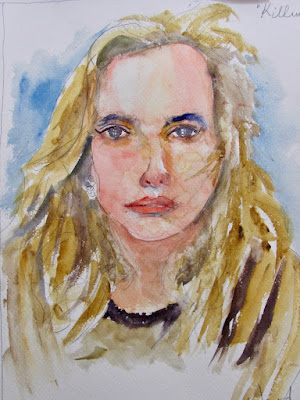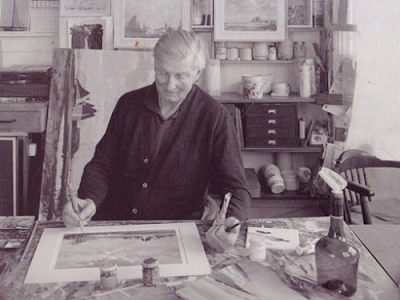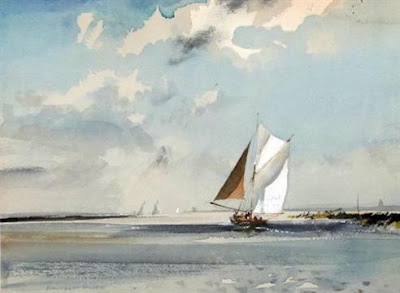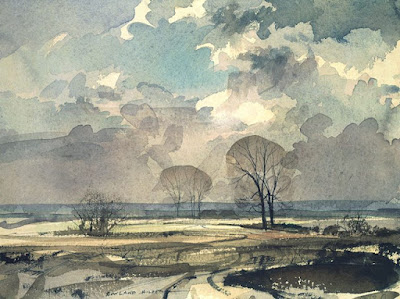I came to watercolour somewhat late in life and initially decided to learn all I could about past English watercolourists, whilst ruining paper and getting a palette together. The end result is over 150 books on the subject as well as almost the same number of DVD’s. Whilst deep into the careers and art of Turner, Wesson, Merriott, Buckle, Muncaster and Seago I always considered Rowland Hilder to be more of an illustrator than a watercolourist, but my opinion was changed dramatically when, whilst on a visit to my native Norfolk, early in this century, we visited a friend of a friends house who I had been told had an impressive art collection.
After a couple of drinks in the garden we were ushered into the lounge and above the mantle piece was a full sheet watercolour of Norwich Cathedral stark white against a thunder storm sky and so obviously a Hilder. The painting was so dramatic and lit up the room. I was told the provenance of the painting and shown other art work in his collection including some paintings of the Scottish Colourists which were impressive, but none caught my interest as did the Hilder.
The Hilder I was more aware of was JJ Hilder, (1881 - 1916) an Australian watercolourist who is to Australian art what Turner is to the English and there have been no fewer than eight artists in the Hilder family since 1788.
Rowland Hilder, of course, is from the same family and was born in New York in 1905 but the family returned to England in 1915 so his father, who was English, could enlist in the army.
His early school years were not happy and his American accent didn’t help matters. He was never happier than when he had a pencil in his hand and an art master suggested to his parents that he should take up art.
He was admitted to Goldsmitth College of Art and initially studied etching and then illustration. He exhibited at the Royal Academy at the age of 18 and the publishers Blackies and Jonathan Cape commissioned him to illustrate their books.,
He lived somewhat frugally as his income from book illustration only netted £120 per annum and it would have been fine had he not decided to marry Edith Blenkiron, a botanical artist whom he met at the Goldsmith College.
In 1928 he was approached by Jonathan Cape to illustrate a reissue of Mary Webb’s book “”Precious Bane” a rural novel set in the villages and countryside of Shropshire. He went to Shropshire with his soon to be wife and stayed at the novelist’s cottage. This was where he realised the potential of the winter landscape as a subject.
During the war, like many artists, Hilder was involved in designing camouflage for the War Office and painting posters for the National Savings Bank which he did for the duration. At the end of hostilities he formed a small family business with his wife and father called “The Heron Press”. They printed, amongst other things, greeting cards.
The cards depicting Hilder’s winter landscapes were very popular and the generic term “Hilderscapes” was born. It was a term he disliked but became resigned to.
At the time Christmas cards usually depicted holly, mistletoe and the mandatory Robin. These were superseded by paintings like “Winter in East Anglia” and “Shipping becalmed - Thames Estuary”This earned Hilder the unenviable title of “The Man who killed Cock Robin”.
Like another high profile artist of his generation, Edward Seago, Hilder had a boat called “Peter Pugg”which he used to sail around the North Sea and Thames Estuary gathering information for his marine paintings.
He became a member of the prestige art group “ The Wapping Group” who painted, sketched and drew on the Thames every week during the summer months, which must have been a nice break from his winter landscapes. He was active in the Group from 1950 to 1972 and was President of “The Royal Institute of Painters in Watercolour” from 1964 to 1974.
Today we think of Rowland as a landscape painter, but in the 20’s, 30’s and 40’s he was looked on as a superb draughtsman and his black and white graphics were second to none. This was where his reputation was initially made and also gave him a head start when it came to watercolour.
I have no idea whether he painted in oils but he certainly painted in acrylics and articles in “The Artist” reveals that he was at the forefront of that medium as soon as it hit the art world.
The articles he wrote for “The Artist” on watercolour were instructive and in depth and many were about a specific pigment - Lamp Black. This is in stark contrast to the lack of information on the accessories he used. There are photographs of him using a box easel outdoors and there are pictures of his studio palette but as for what were his preferred brushes, paper and other accessories I can find nothing.
He tells the story of John Singer Sargent and Monet who used to paint together. Sargent had occasion to borrow Monet’s palette and was amazed to find that black was absent. Monet explained that black doesn’t exist in nature and as a result had no place in his palette. Sargent couldn’t apprehend that someone could paint without using black.
The theory comes from the Impressionists and the idea mainly applies to those who work in oils, but as we know there are more watercolour artists who’s palettes are bereft of black as there are those with it.
Payne’s grey and Neutral Tint are all made today from a mixture of Lamp Black, Monastral (Winsor) Blue and Alazarin Crimson.
Hilder wrote that one can get a full range of neutral greys ranging from black to white using Lamp Black. You can then change the neutral grey tones by changing the hue and you have the formula for making any grey you require ( without resorting to the new Daniel Smith’s superfluous greys).
For a purple grey add a touch of Alazarin Crimson and for a brown grey add Burnt Sienna. A green grey is obtained by adding Cadmium Lemon Yellow. Other yellows mixed with lamp black at differing strengths can give a myriad of greens.
That, more or less, establishes that Hilder had Lamp Black on his palette - Ivory Black he considered too oily and difficult to control in large washes.
Pigments in his palette were:-
New Gamboge, Permanent Yellow, Cadmium Lemon, Raw Sienna, Yellow Orche, Alizarin Crimson, Rose Madder, Burnt Sienna, Light Red, Permanent Mauve, Monastral Green,
Orange, Brown Madder, Vermillion, Cadmium Red, Indian Red, Burnt Umber, Sepia, Ultramarine Blue, Prussian Blue, Cerulean Blue, Monastral Blue, Payne’s Grey, Neutral Tint and Lamp Black.
Rowland Hilder was and is considered to be the quintessential English landscape painter and I suggest even more so than J M W Turner.
I
Regarding books by Hilder John has this to say:.
"There are many books on the art of Rowland Hilder, most are biographies with little or nothing about Hilders watercolour methods. One book I can recommend is "Painting Landscapes in Watercolour". This book contains details of how he treats skies, his palette and several demonstrations together with a substantial gallery".
I have looked into this writes PGW, after my own research and what John has said on the subject. According to this Hilders first book, written in 1966, was "Starting with Watercolour" and this was reprinted in 1989 by North Light Books in America. His next book was "Painting Landscapes in Watercolour " in 1983 , followed by "Successful Watercolour Painting" in 1986. As John states some of the other books attributed to him are in fact edited by Dennis Thomas such as "Sketching Country" in 1991. A check on both Abebooks and Amazon found that most are available on the used market and prices are pretty low. That surprises me a little given his reputation.

The above are more examples of his work. This concludes another excellent piece by John.






























